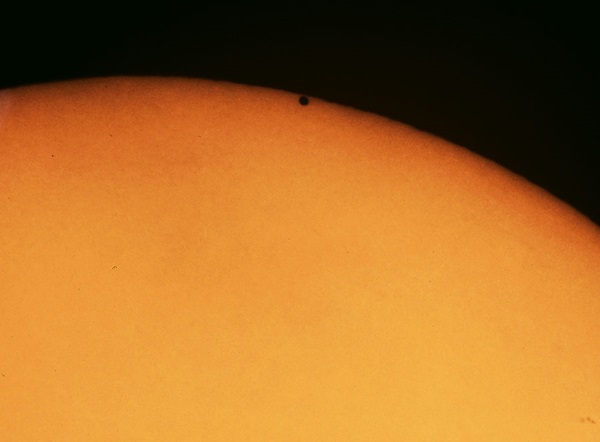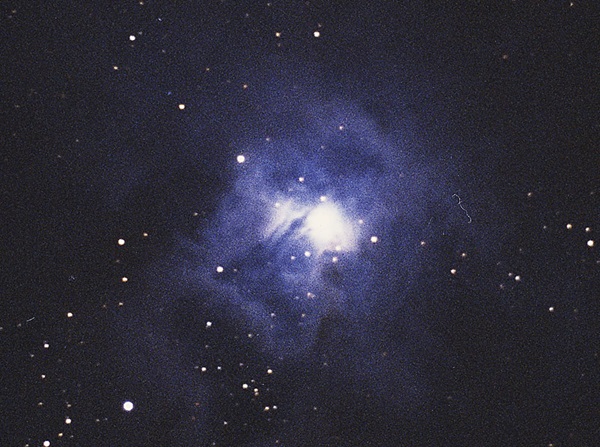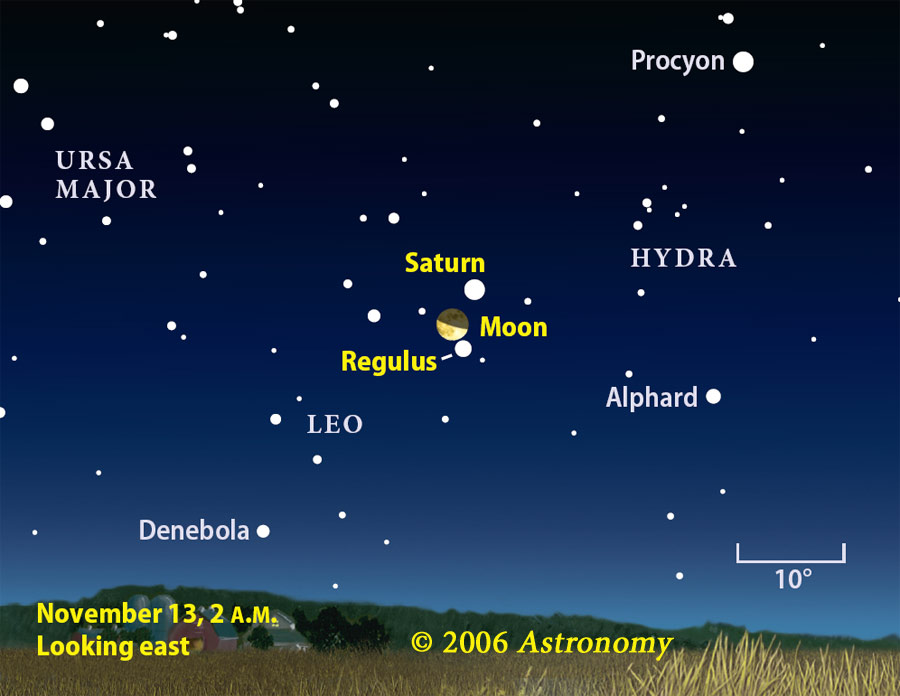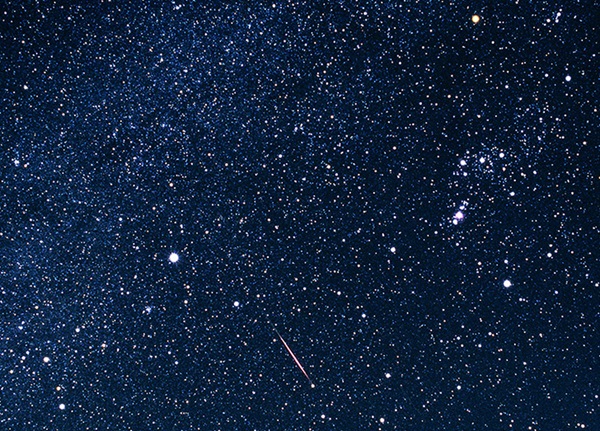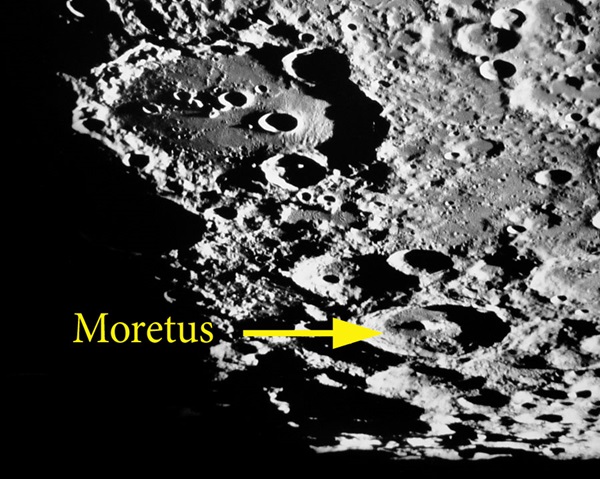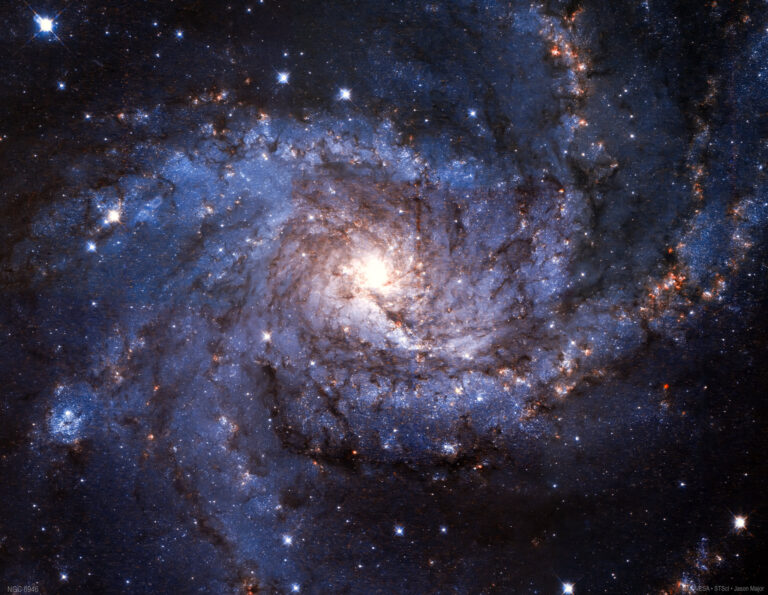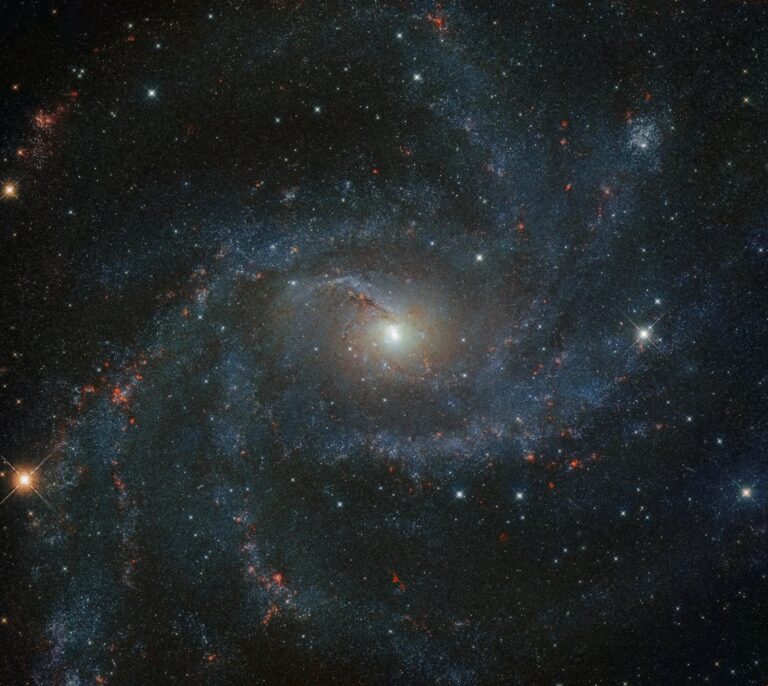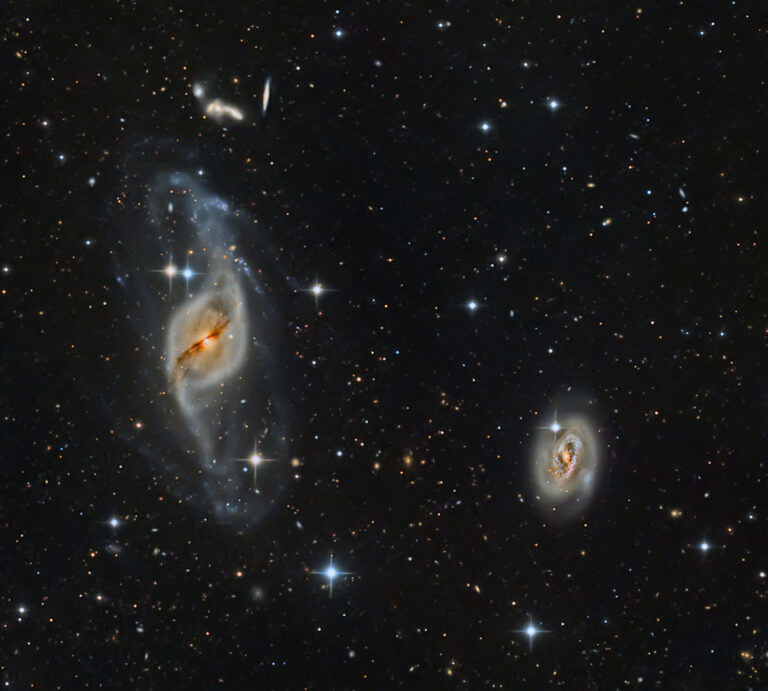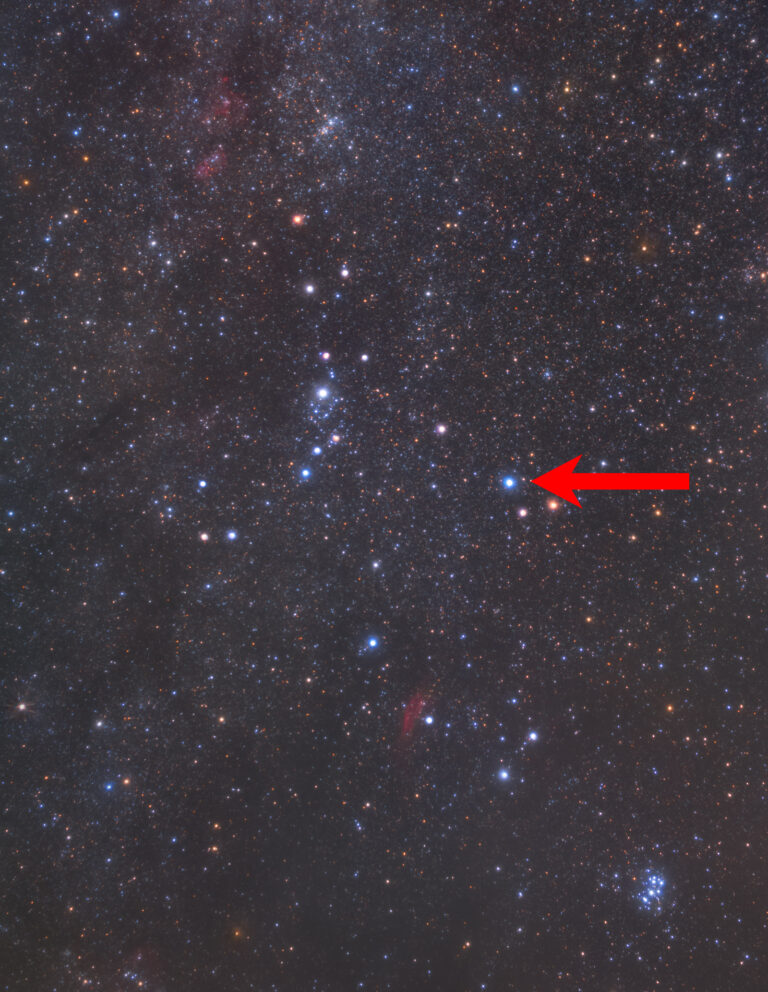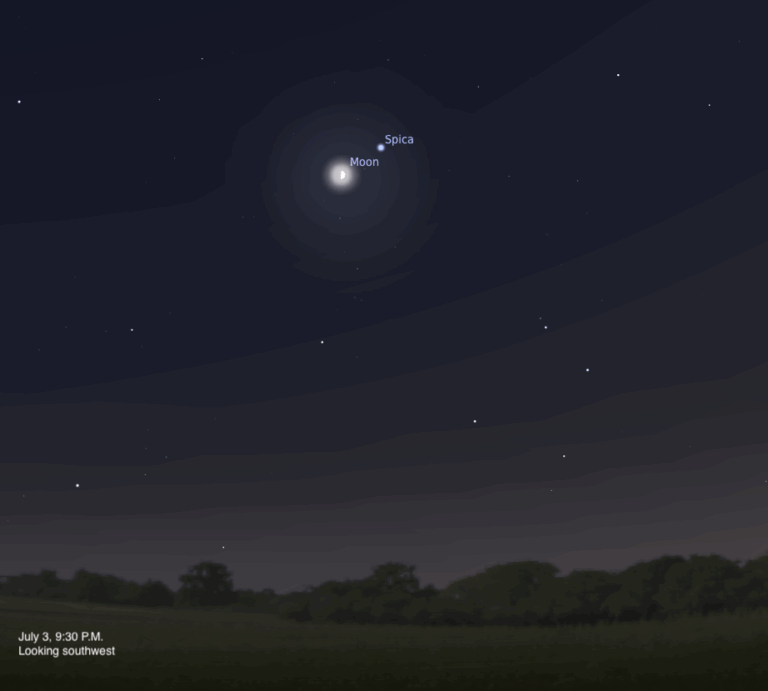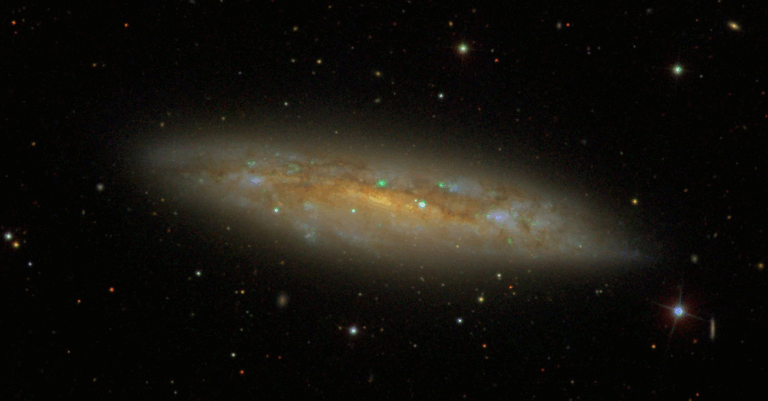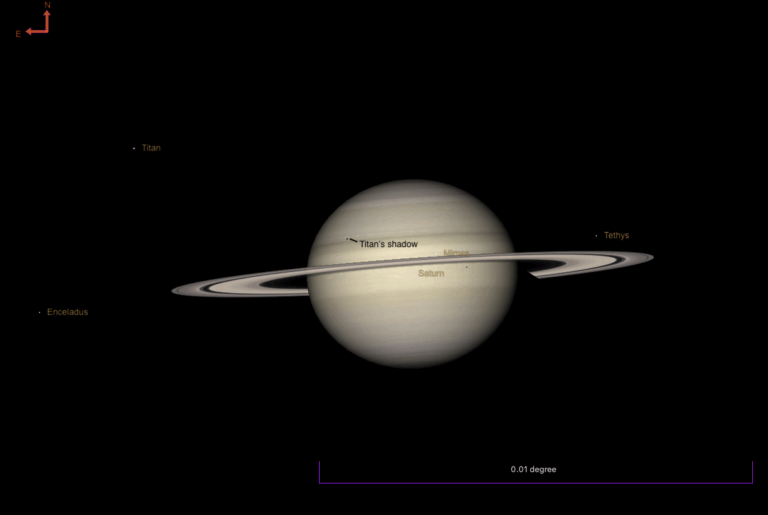Key Takeaways:
The Sun sets before Mercury finishes its transit for all the Americas except along the West Coast. (The planet completes its passage at about 4:10 P.M. PST.) On the plus side, this means we might see some colorful visual effects as the Sun and Mercury set through Earth’s turbulent lower atmosphere.
The next Mercury transit doesn’t come until 2016, so it’s worth heading to clear skies if the weather looks iffy.
Speaking of the weather, November ranks as the cloudiest month of the year for many places in mid- and northern latitudes. The culprit: cold air sweeping over warm, open water. That makes this a good month for telescope maintenance, winterizing, and planning observing sessions. If you own a Newtonian reflector, grab a cup of coffee and practice aligning (collimating) the optics. The experience will help you do it faster when you’re in the field. You’ll be amazed at the detail you can see when the scope’s mirrors are just right.
Saturn rises late this month, cresting the eastern horizon near 11 P.M. Unfortunately, this means crisp, steady images won’t be likely until near dawn, when the ringed planet rides high in the south. On a steady morning, you should be able to spot the planet’s shadow falling on the rings and the Cassini Division; with a 6-inch or larger scope, the inner Crepe ring and delicate cloud bands in Saturn’s atmosphere also appear.
During November’s first week, the Full Moon reveals more of its south polar area than usual. In addition to seeing “past” the pole to glimpse a bit of the lunar farside, we get a nice 3-D effect as shadows exaggerate vertical depth. Normally, a Full Moon looks flat because these shadows are hidden from view.
If you do most of your observing in the evening, try using binoculars to track down the slow-moving asteroid 7 Iris, which lies near the sparkling Pleiades star cluster (M45). Also visible through binoculars, above Polaris in the north, is the yellow variable star T Cephei, which is nearing the peak of its 13-month cycle.
The annual Leonid meteor shower favors night owls. As Earth sweeps through cometary debris, the heat of atmospheric entry makes these dust motes flare into incandescence as “shooting stars.” Don’t expect to see as many meteors as August’s famous Perseid shower produces, but the swiftness of an occasional Leonid and the bright color of the more stately Taurids help make up for lack of numbers.
Finally, astronomical early birds will be rewarded at dawn with Mercury’s best apparition of the year. Only a week after its transit, the innermost planet pierces the dawn glow. Scan the eastern horizon with binoculars around 6 A.M., and look for a peach-colored dot. Just 4 days later, Mercury has brightened by a magnitude and appears easily to the unaided eye. The waning crescent Moon adds a nice touch November 18 and 19.
Cresting high in the northern sky above Polaris, Cepheus the King hangs upside down from his throne. Most people don’t see the throne, but, instead, a child’s simple sketch of a house. Look for a square with a triangle on top, inverted with its peak pointing to Polaris.
As constant as the stars appear, some galactic citizens grow and shrink with a fairly steady pulse of several hundred days. Astronomers predict the Mira variable star T Cephei will reach a maximum brightness around 6th magnitude this month. Through binoculars from a suburban backyard, T Cep then will shine with a noticeable yellow sheen. Over the next several months, it will fade to an orangish 10th-magnitude object.
On the charts, comparison stars have numbers beside them: their magnitude with the decimal point omitted to avoid confusion with a faint star. Find one star a bit brighter than T and another slightly fainter, then figure where T fits on the scale between the two.
You might be surprised at how relaxing this activity is. Not only do you get to see the universe as a dynamic entity, but concentrating on the stars also has a wonderful way of sweeping aside life’s irritants.
Not to be confused with Iris the asteroid, a gas cloud with the same name lies just 1° west of T Cephei. You’ll need a 6-inch telescope to see the glow surrounding a 7th-magnitude star. Technically speaking, the region of gas and dust scatters the star’s light toward us, but we call such clouds “reflection nebulae.”
Discovered by astronomer William Herschel October 18, 1793, the Iris Nebula later was cataloged as NGC 7023.
Even if your telescope’s optics are dusty and produce halos around bright stars, you’ll notice the difference between the Iris’ glow and that of nearby stars of similar brightness. Unfortunately, higher power and bigger scopes won’t resolve the subtle details and curves visible in long-exposure images.
Hebe passes M30
If you enjoy targeting globular star clusters, you’ll eventually visit M30 in southeastern Capricornus. As a freebie this month, the asteroid 6 Hebe glides past the granular globular. Hebe floats about 30′ (the apparent diameter of the Moon) north of M30 the evenings of November 18–21. Only one or two field stars equal Hebe’s brightness of magnitude 9.7.
Mercury skips from evening to morning sky this month and, in the process, performs a rare transit of the Sun visible from most of the United States. This Mercury transit, the last for a decade, highlights November’s planetary action. For those who prefer to observe in the dark, the evening sky nicely displays Uranus and Neptune, while Saturn appears best before dawn. Near the end of the month, Mercury returns to view in the morning sky for a fine performance.
Mercury appears small enough that you’ll need a telescope to spot it. Take great care when observing the transit because, as on every day of the year, the intensity of direct sunlight can damage your eyes in an instant. The safest viewing methods are to project the Sun’s image onto a white card or to place a solar filter over the front of your scope. Make sure the filter is marked clearly with a safety label signifying its suitability for viewing the Sun.
The first bite of Mercury appears on the solar disk’s edge at 2:12 P.M. EST (11:12 A.M. PST). This moment is called “first contact,” and it signifies the transit’s start. People throughout North and South America and in Hawaii will witness this stage. About 2 minutes later, Mercury’s entire disk appears against the Sun’s face — second contact. Over the following 4 hours and 54 minutes, Mercury’s dark silhouette traverses the Sun’s southern hemisphere. At Mercury’s distance of 63 million miles from Earth, the planet’s 3,000-mile-wide disk spans a mere 10″.
Mercury reaches the midpoint of the transit at 4:41 P.M. EST (1:41 P.M. PST), and the Sun sets soon after along the U.S. eastern seaboard.
The transit’s end will be visible only from west of the Rocky Mountains. Third contact occurs at 4:08 P.M. PST, followed 2 minutes later by the transit’s conclusion. Residents of Hawaii and New Zealand can see the entire event. The transit’s final stages can be viewed from Australia, Japan, and eastern Asia, where the Sun rises with the transit in progress.
Mercury transits can occur only in May or November, when the planet crosses the ecliptic plane. And they happen rarely — 13 or 14 times per century. The next Mercury transit occurs May 9, 2016.
For more details, see “Mercury crosses the Sun” on page 80 in this issue.
The star chart on page 54 shows the stars Iota (ι) and 29 Capricorni. Neptune lies midway between this pair. Swing a scope toward Neptune, and you’ll spy its tiny, 2.3″-diameter disk. Look carefully, and you should see subtle differences in its appearance relative to stellar images. Neptune’s steadier, non-twinkling radiance and its blue-gray color give away its planetary status.
In the southern half of the sky during the early evening, the 1st-magnitude star Fomalhaut shines brightly. High above it, halfway to the Great Square of Pegasus, Uranus lurks near the 3.7-magnitude star Lambda (λ) Aquarii. This star will be easy to spot, and 5.8-magnitude Uranus lies less than 1° southwest of it.
A small telescope will show Uranus’ 3.6″-diameter, blue-green disk. Unfortunately, the planet’s elusive atmospheric details are seldom seen from the ground by optical observers. Uranus sets shortly after midnight in mid-November.
On the morning of November 13, American observers will find a waning crescent Moon approximately 2° north of Regulus. This meeting creates a wonderful trio of objects rising around midnight local time.
By dawn, the ringed planet has climbed high in the southeast, a good time for telescopic viewing. Saturn’s rings now tilt 12° to our line of sight, providing magnificent views of their sunlit southern side. The two main rings, the outer A ring and the brighter B ring, can be seen through most scopes. On nights with good seeing, the faint inner Crepe ring, or C ring, also appears through 6-inch or larger telescopes. The Cassini Division that separates rings A and B shows up best at the rings’ far ends.
Try to spot the shadow of the planet’s disk as it falls on the rings’ western side. This shadow shrinks as Saturn approaches opposition in February, and it switches to the rings’ eastern side after opposition.
Although Saturn’s disk looks relatively bland, the bright equatorial zone alongside the neighboring, and slightly darker, south equatorial belt usually can be seen under good conditions. You also can track Saturn’s numerous moons as they circle the giant planet. The brightest, Titan, orbits in 16 days and glows at magnitude 8.4. You’ll find it due north of Saturn the mornings of November 1 and 17, and due south of the planet the mornings of November 9 and 25.
Spotting the planet’s inner moons proves more challenging thanks to their relative faintness and proximity to Saturn’s glare. Mimas lies closest to Saturn of the major moons. It glows at magnitude 12.8 and lies only 1.5 planet-diameters away from Saturn’s center. Enceladus lies about 2 planet-diameters away and glows a little brighter, at magnitude 11.8.
Other moons are easier to spot. In order of increasing distance from Saturn, they are Tethys (magnitude 10.3), Dione (magnitude 10.4), and Rhea (magnitude 9.7). At their greatest elongations from Saturn, these moons lie 2.5, 3.1, and 4.4 planet-diameters from Saturn’s center, respectively. Elsewhere in their orbits, they appear closer to the planet.
The innermost planet arrives at greatest elongation November 25, when it stands 20° west of the Sun. Shining at magnitude –0.5, Mercury appears impressive in the eastern sky before dawn. The planet rises 100 minutes before the Sun and clearly outshines the 1st-magnitude star Spica in Virgo, which then lies higher in the southeast. Mercury remains on view through the end of the month, brightening slightly to magnitude –0.7. Venus, Mars, and Jupiter all lie too close to the Sun for viewing this month. But mark your calendar for early December, when Mars and Jupiter have a spectacular morning conjunction with Mercury.
The Leonid meteor shower has lost some of its mystery but none of its charm over the past several years. Thanks in large part to the work of David Asher of Armagh Observatory in Northern Ireland and Robert McNaught of the Australian National University, the past few years have seen a dramatic increase in our understanding of this shower. They successfully predicted major Leonid storms by calculating Earth’s passage through trails of debris left behind during previous returns of the shower’s parent comet, 55P/Tempel-Tuttle.
The Leonids’ traditional peak — when Earth passes through the plane of Tempel-Tuttle’s orbit — is November 17. This peak should bring about one meteor every 3 minutes, on average. Combined with the brief increase expected November 19, a broad window of 3 mornings should offer good Leonid viewing. The waning crescent Moon makes conditions close to perfect, and all the more attractive, for meteor watching in the predawn sky.
The Moon’s northerly declination around the November 5 Full Moon offers observers a fine chance to view the Moon’s southern polar region under full illumination. The large crater Clavius will appear more rounded than usual; and closer to the pole, you’ll get a good look at Moretus.
Moretus is a magnificent 71-mile-wide crater with a central mountain peak towering 1.5-miles high. The crater’s terraced walls remind some observers of the better known crater Tycho, located farther north. The Moon’s zero longitude runs tangent to Moretus’ eastern wall.
Southeast of these two craters lies the complex region of the southern pole. The Leibnitz Mountains stretch across the region, although they actually form part of the rim of a huge depression that sinks 5 miles below the Moon’s average radius. If conditions are just right, you might spy the crater Shackleton, named after the famous British polar explorer.
It lies at the Moon’s south pole. The Clementine spacecraft detected evidence of ice inside this crater, in a region that remains in perpetual shadow.
When the Moon reaches full phase November 5, you’ll find that a lunar filter will cut the glare, allowing careful study of this fascinating region.
Many asteroids revolve around the Sun in relatively circular orbits between Mars and Jupiter. For example, 1 Ceres has a rounder orbit than Mars, and Ceres’ peak brightness remains pretty much the same from one appearance to the next.
To locate Iris, set your sights on the beautiful Pleiades star cluster (M45) in Taurus, now rising in the east after darkness falls. Move from the handle of M45’s mini-dipper through the bowl by a full binocular field. With the exception of a handful of field stars, Iris will be the brightest object in this region, making it a snap to track this month. Avoid the nights from November 4 to 6, when light from the nearby Full Moon will drown out Iris.
Did you happen to watch the fascinating breakup of Comet 73P/Schwassmann-Wachmann 3 this past spring? It surely was a treat, the likes of which we’re not likely to see for many years.
The vast majority of comet nuclei — dirty snowballs of ice and dust — don’t go through antics like that, particularly comets that keep their distance from the Sun. This month, Comet 4P/Faye cruises quietly to the east (left) of Alpha (α) Piscium and appears low in the east as twilight descends.
12-inch scope, Faye will look much nicer from rural locations away from streetlights through a 5- or 6-inch scope. (Unfortunately, it lies beyond the reach of typical binoculars.) By November 10, the comet sits decently above the eastern horizon in a dark sky.
A comet looks the way it does because the Sun heats the nucleus’ various ices. Sunlight causes these ices — frozen water, carbon monoxide, and carbon dioxide, among others — to sublimate, or change directly from a solid to a gas. The small nucleus’ weak gravity can’t hold onto either the gas or the dust particles released with it.
This gas and dust form an amorphous cloud, called the coma, that surrounds the nucleus and can span a million miles. The Sun’s radiation and magnetic field push the coma’s gas and dust away from the Sun, creating two separate tails.
Comet Faye should sport a bright, condensed core and a short tail heading northeast. Astronomers call the starlike center the “false nucleus” because a shroud of sunlit dust obscures the comet’s actual surface. Don’t get confused the nights of November 11 and 22, when the coma passes in front of a bright field star. On the positive side, such a bright marker makes it easy to see the comet move over a few hours.

